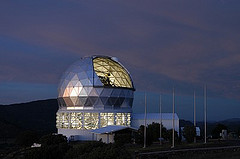 Graduate student Sara Gettel, whom I co-advise, has been working hard for the past several months to characterize three exoplanets orbiting giant stars. This is work she is doing for her PhD thesis with Prof. Alex Wolszczan here at the Center for Exoplanets and Habitable Worlds. One of the stars also has an additional object orbiting it with a very long orbital period, but it’s not yet clear what it is; it could be another star, or even a brown dwarf. Ms. Gettel used the radial velocity method to detect the planets, from spectra taken with the High Resolution Spectrograph at the Hobby-Eberly Telescope.
Graduate student Sara Gettel, whom I co-advise, has been working hard for the past several months to characterize three exoplanets orbiting giant stars. This is work she is doing for her PhD thesis with Prof. Alex Wolszczan here at the Center for Exoplanets and Habitable Worlds. One of the stars also has an additional object orbiting it with a very long orbital period, but it’s not yet clear what it is; it could be another star, or even a brown dwarf. Ms. Gettel used the radial velocity method to detect the planets, from spectra taken with the High Resolution Spectrograph at the Hobby-Eberly Telescope.
The paper is available on astro-ph already, and has been accepted to the Astrophysical Journal.
These planets are orbiting giant stars. Giant stars have used up their hydrogen nuclear fuel and are burning helium, instead. Helium burns hotter and brighter than hydrogen, so the star must expand and the surface must cool to accommodate all of the extra energy coming out. This stage won’t last very long (in a cosmic timescale) and the stars will eventually run out of core helium and stop burning; in the meantime the helium burning will become unstable and the stars will lose their outer envelopes. What will remain is a white dwarf, a hot, slowly cooling ember the size of the Earth but nearly the mass of the Sun.
When this happens, the planets’ orbits will grow as the stellar envelope escapes, or they may be enveloped by the star in its final death throes, when it will become quite large. If they survive, they will then be orbiting a white dwarf.
Something like that was recently discovered by Prof. Kevin Luhman of the Center for Exoplanets and Habitable Worlds. Using Spitzer imaging, Prof. Luhman discovered a very cold object, probably about 8 times the mass of Jupiter, in a very wide orbit around a white dwarf. It is almost certainly a huge ball of hydrogen, like our own planet Jupiter. It is perhaps the coldest such object ever found (recently the WISE spacecraft discovered several of these newly-classified “Y dwarfs”, and it is unclear which object holds the record for coldest). This object also challenges our clean taxonomy between “exoplanets” and “brown dwarfs” since it’s not clear how it formed.
Image credit: Janella Williams

